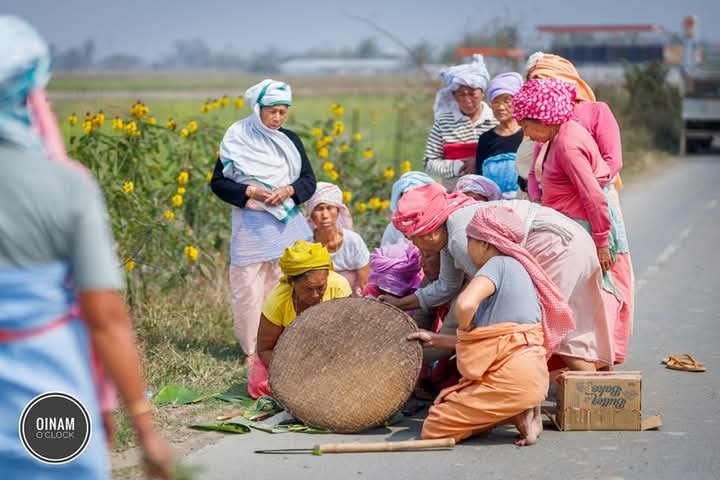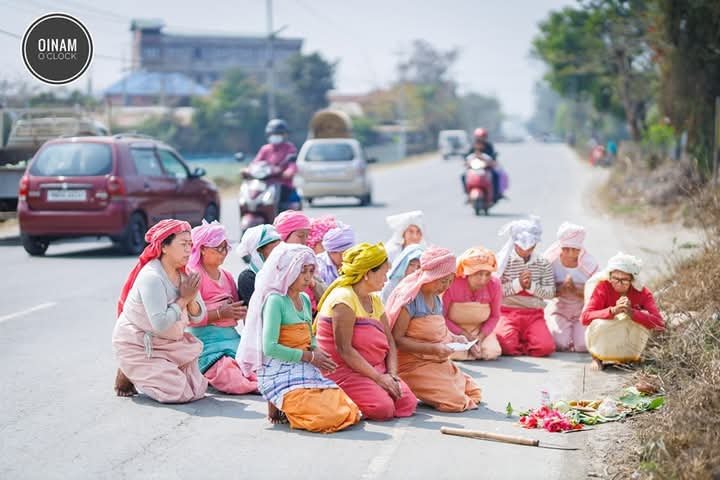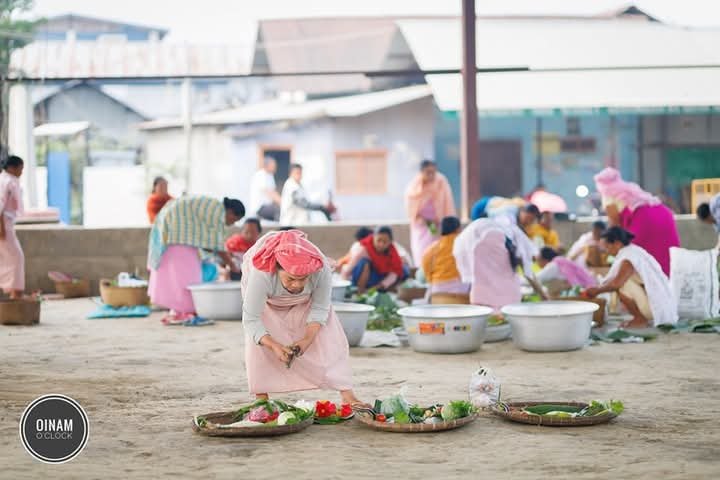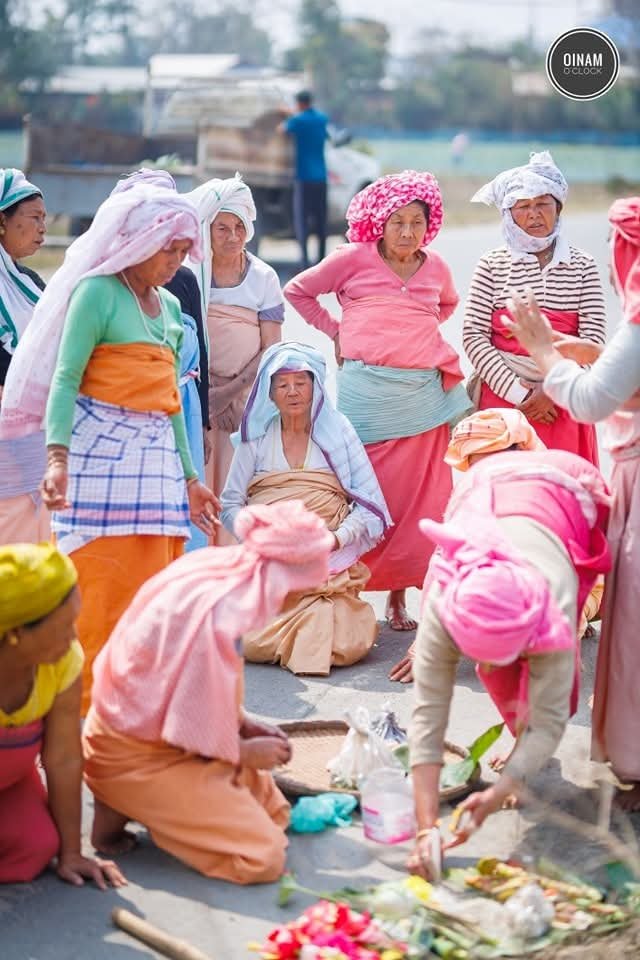
Lamta, the final month in the Meitei calendar, is a bittersweet time for the people of Manipur. While it’s a period of joy and revelry with the celebration of the Yaoshang festival, it’s also a time of trepidation. The Yaoshang festival is undoubtedly a beloved event, transcending age boundaries and bringing people together. However, the Saturdays of Lamta, known as ‘Lamta Thangja‘, are steeped in superstition and fear.
According to Meitei lore, this period is inauspicious, and the mysterious ‘Saroi Ngaroi‘ is said to roam, claiming lives. This eerie belief casts a shadow over the otherwise festive atmosphere, making Lamta a complex and intriguing time in the Meitei calendar.
This article will explore the fascinating story of the Saroi Ngaroi, uncovering their origins and the eerie spirit of Lamta Thangja. It will also delve into the popular Henjunaha folktale, a captivating narrative that has been passed down through generations.
Etymology:
The term “Saroi-Ngaroi” has been subject to various interpretations. According to Saroj Nalini Arambam Parratt’s “The Religion of Manipur” (1980), the term literally translates to “beast and fish creatures,” referring to malevolent spirits that harbour evil intentions towards humans. In contrast, J. Shakespeare’s “Religion of Manipur, Folklore” (1913) defines it as “those who accompany beasts and fishes.” Despite minor variations in translation, the consensus remains that Saroi-Ngaroi are evil spirits, perpetually seeking to harm humanity.
Origins:
The origin story of the Saroi Ngaroi remains shrouded in mystery, with no definitive account available. One narrative, as recorded in J. Shakespeare’s “Religion of Manipur” and J.C. Higgins’ “Notes on Meithei,” suggests that the Saroi Ngaroi are the offspring of Guru Sidaba and Leimaren. According to this story, Leimaren gave birth to a son while Guru Sidaba was away. Upon his return, she asked him to name the infant. Guru Sidaba provided seven names, none of which Leimaren liked. As a god, Guru Sidaba was unable to retract the names, so he created seven additional beings to bear them. Ultimately, Leimaren accepted the final name, “Sanamahi,” and the seven other beings, bearing the names given by Guru Sidaba, became the Saroi Ngaroi. However, this narrative is considered unsatisfactory and is believed to be a later invention, likely emerging after the introduction of Hinduism.
Another narrative suggests that after the Ultimate God created humanity, people became increasingly greedy and arrogant. In response, the Ultimate God summoned all the Gods and Goddesses, including the Saroi Ngaroi, to curb humanity’s growing supremacy. Notably, this story portrays the Saroi Ngaroi as “supernatural beings that accompany the Supreme Lord,” rather than malevolent entities. Instead, their primary objective is to protect humanity from disease and death.
Lamta Thangja:
Lamta Thangja corresponds to the Saturdays of Lamta, the final month in the Meitei calendar. According to widespread belief, the first and second Saturdays of Lamta mark a significant occasion. On these days, the Saroi Ngaroi of the current year converge at the lamlong ahum phangba, a divergence road where three paths meet, to meet their successors for the upcoming year. At this site, the outgoing Saroi Ngaroi relinquishes their duties, handing them over to their incoming counterparts. Furthermore, a list known as “shingthek singthaba” in Meiteilon is compiled, enumerating the individuals destined to pass away in the forthcoming year.
The origins of the Lamta Thangja rites date back to the time when the Gods sought to establish a connection with the Saroi Ngaroi. Legend has it that the Saroi Ngaroi had settled in the Nongpok Leihao Ching at the same time the Gods intended to occupy the same land. A conflict ensued, with the Gods burning down the Saroi Ngarois’ homes, causing them to suffer. To avoid further bloodshed, the Gods and Saroi Ngaroi chose to coexist, mutually blessing each other’s needs. As a result, the tradition of offering sacrifices to the Saroi Ngaroi began, specifically on the first and second Saturdays of the Lamta month, aimed at appeasing them and preventing interference in human lives.

Saroi Khangba:
Saroi Khangba is a ritual designed to exclude individuals listed on the Shingthek Singthaba, a registry compiled by the Saroi Ngaroi. According to Waikhom Romesh’s “Anganba Manipur Culture gi Mashak” (2003), this ritual was introduced by the Lairembi Taret, a group of seven angels- Heipokleima Monshabi, Lalambung Leima Hemoibi, Nongmeibung Leima Emoinu, Langjingleima Piyanu, Liwaleima Tengolchaibi, Chingaleima Lanheibi, and Pishumleima Saphabi. Over time, the Lairembi Taret were replaced by seven elderly women from each locality, who perform the ritual on the first two Saturdays of the Lamta month.
During the ritual, these elderly women go door-to-door, collecting various food items, including rice grains, vegetables, and dried fish (ngari). They then gather at the lamlong ahum phangba, where they offer the collected food to the Saroi Ngaroi. On this day, families also make offerings to their household deity, Lord Sanamahi, praying that he will exclude their family members from the Shingthek Singthaba list. As the supreme God, Lord Sanamahi is believed to have the power to access and alter the list, thereby protecting those who offer prayers and make offerings to him.

Henjunaha:
As Lamta Thangja approaches, elderly storytellers traditionally regale their young listeners with the ancient tale of Henjunaha and Lairoulembi. This timeless folktale, deeply rooted in local tradition, offers a fascinating glimpse into the cultural heritage surrounding Lamta Thangja. Here’s a brief retelling of this captivating story:
As the reign of the gods drew to a close and the era of human dominance was about to commence, the gods ascended to heaven. The Saroi Ngaroi, left behind on earth, felt forsaken and complained to the gods. Thangjing, the god, appeared and assured them that he would reincarnate on earth in human form, and that the Saroi Ngaroi would play a role in this earthly drama. True to his word, Thangjing reincarnated as Henjunaha, while his consort, Paloitabi, took the form of Lairoulembi, Henjunaha’s earthly lover.
Henjunaha was born to Langlenhanba, a skilled carpenter, and his wife, Khoidom. Langlenhanba had once presented a magnificent boat to the King of Moirang during a festival, which so impressed the monarch that he granted Langlenhanba permission to harvest any wood from the kingdom. The king also gifted him a majestic Kangjei, a polo stick imbued with the power to ward off evil spirits.
Elated by the king’s gift, Langlenhanba sought to create another magnificent boat. He ventured to the Thangjing hill in search of the finest wood, where he chanced upon a majestic tree. Without offering the requisite prayers, he struck the tree with his axe, and to his horror, blood began to ooze out. The tree, it turned out, was a spirit that had taken on an arboreal form. Langlenhanba’s fate was sealed; he passed away that very day, leaving behind his wife and young son, Henjunaha.
As Henjunaha grew into a handsome young man, he met Lairoulembi, the beautiful daughter of a wealthy family. The two fell deeply in love, but their social differences proved to be a significant obstacle. Lairoulembi’s parents refused to accept Henjunaha, the son of a poor widow, as their son-in-law. Undeterred, Lairoulembi concocted a plan to elope with Henjunaha on the night of the first Saturday of the Lamta month.
Hanjunaha’s mother, however, had warned him against venturing out on this inauspicious day. But love proved to be stronger than caution, and Henjunaha set out to meet Lairoulembi, armed with the sacred Kangjei bestowed upon his father by the Moirang king. As he journeyed through the darkness, he stumbled upon a group of men feasting on the road. Henjunaha joined in, only to discover that the food on his plate consisted of human fingers. The gruesome reality dawned on him – the feast was an offering to the Saroi Ngaroi.
Without hesitation, Henjunaha fled, pursued by the vengeful spirits. He valiantly wielded the Kangjei to ward off his attackers, but ultimately, he succumbed to their relentless pursuit. As he lay lifeless on Lairoulembi’s courtyard, she emerged from her home, only to be met with the horrifying sight of her beloved’s lifeless body. Overcome with grief, Lairoulembi took her own life, stabbing herself in the heart with a knife.
Thus, the tragic tale of Henjunaha and Lairoulembi came to a heartbreaking end.

References:
- J Shakespeare (1913).”The Religion Of Manipur, Folklore Journal“
- Saroj Nalini Arambam Parratt (1980). “The Religion Of Manipur“
- Higgins, J.C. (1997). “Notes on Meithei (Manipuri) Beliefs and Customs“
- Waikhom Romesh (2003). ‘Anganba Manipur Culturegi Mashak“
- K.B. Sharma (2010). “Henjunaha“
- Prembati Sharma (2024). “Practice of Totemic Rituals in Meitei Culture“
- Pureljeet Loushambam, Dr. Sakshi Singh (2024). “Delving into the Henjunaha Folktale: Uncovering Cultural Significance, Symbolic Narratives and Identity“
- Waikhom Renuka Devi (2024). “Ritual Practices of the Meeteis“
Daniel Yumkham | Film Critic and Researcher
Passionate about history and Manipuri culture, Daniel shares film reviews and research on:
-Manipuri Cinema (Instagram : thefilmdiary )
-Regional History and Traditions.

